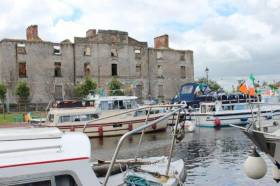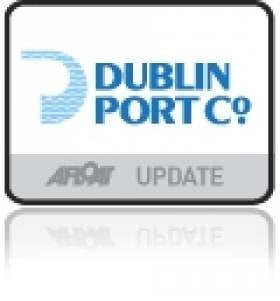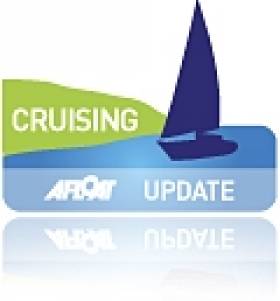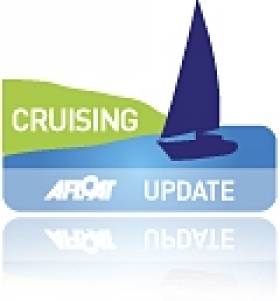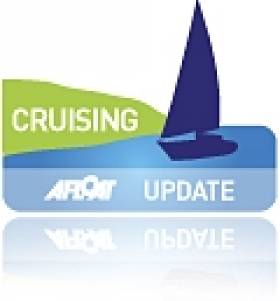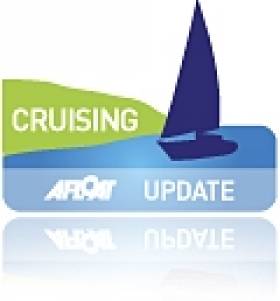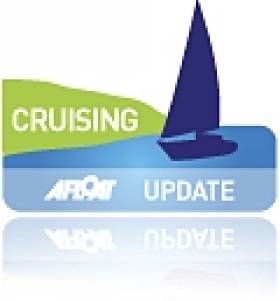Displaying items by tag: Rally
Shannon Harbour Canal Boat Rally Is Back On The Agenda
#Heritage - The Shannon Harbour Canal Boat Rally will go ahead this month, despite reports of its recent cancellation.
Afloat.ie has learned that a new voluntary group has taken over the hosting of the rally, after Inland Waterways Association of Ireland (IWAI) Shannon Harbour branch chair Damien Buckley announced it would no longer be running.
Gerry Burke of the IWAI’s Lough Derg branch led the charge to maintain the tradition of the heritage event during the recent Jamestown Heritage Festival in Kildare.
It means 2018 will indeed mark the 47th edition of the Shannon Harbour Canal Boat Rally, which will take place over the weekend of Friday 15 to Sunday 17 June.
The sixty-boat twelve-day Irish Cruising Club Cruise-in-Company in northwest Spain comes to a conclusion in Bayona tonight after an impressive display of well-planned logistics by lead organiser Peter Haden and his team writes W M Nixon. This saw the many participants provided with a reasonable number of options in organised events afloat and ashore, yet at the same time there was plenty of scope for “cruises-within-the-cruise” for smaller groups of buddy-boats in the fleet.
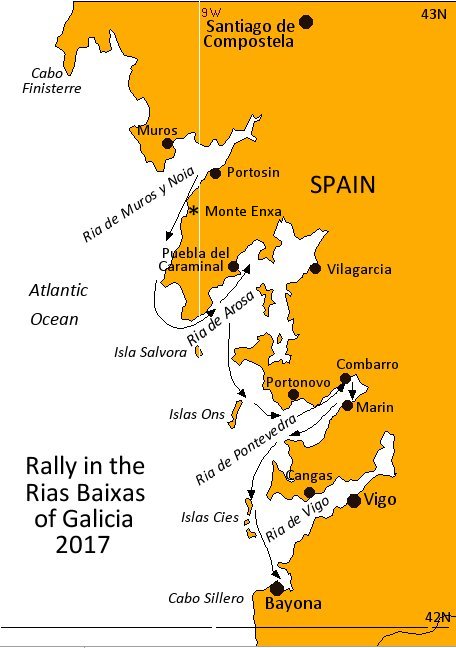 This chartlet indicates the broad movement southward of the 60-boat fleet – there were many options available for private ventures by smaller numbers of boats. In addition, with a significant Ocean Cruising Club contingent within the ICC membership, a joint meet with raft-up possibilities was organised with the OCC on Tuesday of this week at Ensenada de Barra. This produced a notable array of renowned cruising vessels, many of which have voyaged tens of thousands of miles.
This chartlet indicates the broad movement southward of the 60-boat fleet – there were many options available for private ventures by smaller numbers of boats. In addition, with a significant Ocean Cruising Club contingent within the ICC membership, a joint meet with raft-up possibilities was organised with the OCC on Tuesday of this week at Ensenada de Barra. This produced a notable array of renowned cruising vessels, many of which have voyaged tens of thousands of miles.
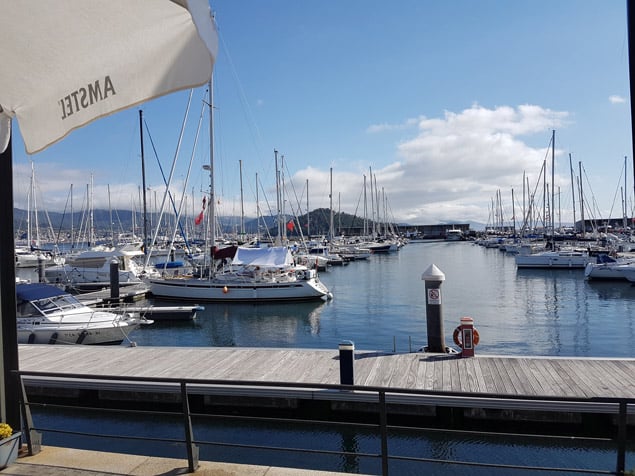 The ICC fleet used both marinas and anchorages – this was one of the early overnights at Caraminal. Photo: Tansey Millerick
The ICC fleet used both marinas and anchorages – this was one of the early overnights at Caraminal. Photo: Tansey Millerick
While the early days of the rally saw some fog and even a spot of rain, as the fleet has progressed southward from Portosin towards Bayona the conditions have steadily improved, and they are now well clear of the unsettled weather which has been developing beyond the northern areas of the Bay of Biscay.
In fact, it is currently Galicia at its very best, and the organisers who calmly kept at the job despite numbers involved soaring through all expectations, and the many boats which voyaged both from Ireland and other places to share the ethos of this remarkable club in a very special setting, deserve much credit for a combined effort which well expresses the spirit of the Irish Cruising Club.
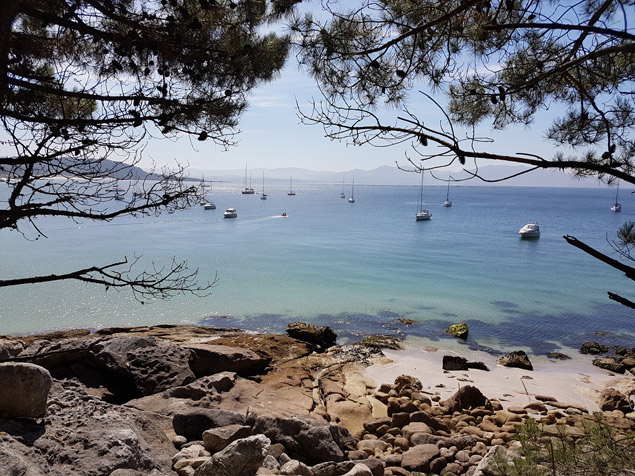 Galicia at its best – a daytime beach anchorage off Ensenada de Barra. Photo: Tansey Millerick
Galicia at its best – a daytime beach anchorage off Ensenada de Barra. Photo: Tansey Millerick
30th ARC Rally – Mid-Way to St Lucia
With most of the cruising fleet around the half-way mark, Frank Quinn updates his earlier report on the 30th ARC Rally for cruisers that includes three Irish boats
It was a windy and lumpy start as the fleet in the 30th ARC left Las Palmas on 22 November. 25 knots, gusting 30, would be weather most coastal sailors would regard as their signal to stay in port. In the case of ocean crossings, it's business as usual -- although our skipper did comment that the start was delayed in the past under similar conditions.
Las Palmas harbour was alive with well-wishers and jostling boats for an hour before the off: the racing fleet going first, followed by the cruising division. Aboard Nina, Stephen Cooke's Nordship 43 DS, the sense of anticipation was huge as we reefed down for our first night. A quartering 10 ft swell, coupled with following 25 knot wind, kept the watches busy. With six on board, we have opted for the classic delivery crew pattern of 4 hours on/4 hours off.
Briefings in Las Palmas recommended rounding the island then making straight for St Lucia. Our skipper preferred to head south first, a decision which proved worthwhile. Although we had three days of roller-coaster sailing, we gradually picked up more even seas before we turned to the west. Here at the half way point after 13 days, we expect to make up time now that we are on the rhumb line directly to Rodney Bay.
Sailplan is a poled-out genoa with reefed main, delivering a reliable 7-8 knots. With the exception of one calm day, we have had nothing but steady 17-25 knots on our starboard quarter. On the day the wind died, we flew our cruising chute for a pleasant six hours in the sunshine. On board, life has settled into a routine around sailing, sleeping and eating. Boat systems are working well, particularly the Raymarine autohelm which is flawless -- although it relies on the generator to keep batteries alive. The only thorny issue so far has been a leaky bolt on the Hydrovane self-steering. With following seas, its transom mounting has been under pressure. Yesterday we hove-to, removed the bolts and resealed them: stern cabin floor is dry again.
We learn from the ARC reports that several boats who took the northern route suffered gear damage and diverted to the Cape Verde Islands for repair. One boat had a medical emergency and managed to hook up with a passing freighter for help.
At 1940 on Thursday (3 December) the skipper of Magritte to advised the yacht was taking on water. The source of the ingress could not be identified or stemmed and the four crew on board indicated that assistance was required as the situation worsened. On the advice of MRCC Falmouth, a MAYDAY was issued and the yacht’s EPIRB activated. The liferaft was readied in anticipation of a possible need to abandon the yacht.
MRCC Cape Verde coordinated the evacuation of the crew. Cargo vessel SCL Basilea diverted to provide assistance, reaching Magritte at approximately 0500 (UTC). The crew were safely evacuated and are all well on board SCL Basileawhich is now en route to Spain. Magritte was abandoned at approximate position 16 44.36N 027 27.82W.
What of the three Irish boats in the ARC?
Alpaire, a Hallberg-Rassy 48 skippered by Des Cummins in 634 miles to go; Crackerjack, Colum O'Sullivan's Oyster 53 has 848 miles; and BAM, Conor Fogerty's HYC-based Sun Fast 3600, among one of the smallest boats in the racing fleet, has just 600 miles to the finish line.
Reporting in from Crackerjack on December 2nd, Tralee SC's Brian O'Sullivan told Afloat.ie: 'We passed mid way point & running downwind at 7 to 8 kts all day. No sightings other than whales and flying fish for 5 days! Great on board, eta Dec 12th'
The ARC camaraderie pops up every now and again on the VHF, when AIS signals appear on nav station plotters. Not just the ARC boats: a shout came in last night from Nomad IV, a 98' yacht racing a TransAt with a crew of 17. They passed at 18 knots six miles to N, happy to chat and warning of upcoming squalls.
With our target of 150 - 180 miles a day, Nina is looking good for an overall crossing time of 21 days. The trade winds are steady, she is a fine seagoing boat and we have plenty of chocolate HobNobs on board. In the ongoing swell, this definition of the perfect seagoing cook, courtesy of author Theo Dorgan, is particularly apt:
"A fireproof, acrobatic contortionist, with a strong stomach, an ability to work fast and a distinct masochistic streak".
Dublin Port Company Launches Dublin 'Vintage Port' Rally To Tie in With Parade of Sail
#dublinport – Ireland's oldest Garda car was back on duty for the first time in over eighty years today, to help launch the inaugural Dublin "Vintage Port" Rally which is being supported by Dublin Port Company. The 1927 Model T Ford of Dublin Metropolitan Police (DMP), later to become An Garda Siochána, will be one of over 150 beautifully maintained and rarely seen trucks, classic buses, vintage & classic cars and veteran fire & military vehicles on show. The rally takes place this Sunday 28th September from 10am – 6pm at Dublin Port's Trade Car Compound. The rally coincides with Dublin Port's Parade of Sail, which will see a flotilla of over 40 sail boats sail along the River Liffey to mark the recent installation of new permanent pontoons on the River Liffey at North Wall Quay.
Commenting, Eamonn O'Reilly, Chief Executive of Dublin Port Company, said, "The bygone sound of classic engines will be heard throughout Dublin on Sunday, as veteran, vintage and classic commercial vehicles from all over Ireland roar into Dublin Port for the inaugural Dublin "Vintage Port" Rally. The rally offers families a truly unique opportunity to view a slice of Ireland's by-gone transport history and I would encourage all Dubliners and visitors to come along to Dublin Port and enjoy a great day out in aid of Barnardos."
Commenting, Ed O'Neill, organiser of the Dublin 'Vintage Port' Rally said, "The rally provides a wonderful opportunity for classic vehicle enthusiasts to view up close a huge selection of the very best commercial and private vintage vehicles in the country. The 1927 DMP/ Garda Car will be just one of many fascinating vehicles on show."
Highlights of the rally include Dublin's oldest double decker bus, Leyland Titan TD4, RI of the Dublin United Transport Company, which dates back to 1937 and a Dennis F8 NIK 888 Fire Engine, which served Dubliners faithfully from 1956 to 1984.
As well as the many classic vehicles on show, there will be exhibition stalls, a children's play bus, model truck and bus exhibition, transport-themed stalls selling collectibles and food kiosks. Families will also be able to enjoy a nostalgic vintage bus trip on a London Routemaster Bus which will be giving guided tours of Dublin Port on the day
The rally will run from 10am – 6pm, at Dublin Port's Trade Car Compound, located at the junction of Sheriff Street Upper and East Wall Road. Access is via the main gate on East Wall Road. While some parking will be available on site and can be accessed via Alexandra Road, the public is encouraged to travel by the LUAS Red Line which terminates across the road from the rally venue.
More here
Caribbean Christmas Rally Cruisers Expected in Antigua on December 29
#christmasrally – Strong winds but a relatively smooth sea state provided a fast exciting start to the Christmas Caribbean Rally.
The fastest boats in the rally, which set out from Lanzarote on December 16th, have about 1200 nm to go to Antigua. The fleet is being lead by Spanish flagged Ocean Phoenix, a Rob Humpreys 77, with Eduard Numan's Dutch Shipman 63, Jinthe close behind.
Eduard is a sports fanatic taking part in hockey, ski-ing, golf and cycling in his home town of Amsterdam. It has been Edu's ambition to sail across the Atlantic and cruising through Patagonia is also high on the agenda for Jinthe. Before the start of the Christmas Caribbean Rally, Jinthe built up a friendly rivalry with Juan Luis Serra, skipper on Ocean Phoenix. For the moment, Ocean Phoenix has the upper hand and Ocean Phoenix also has a secret weapon, First Mate 'Duna'. Apparently the 8 year old poodle is handy around the boat and is as wily as an old fox when it comes to the navigation!
Husband and wife, Alan and Terry Ryall are sailing two up on an Island Packet 465, Seminole Wind. The British couple have sailed two-handed before but never across an ocean. Terry has been providing regular blogs since the start of the Christmas Caribbean Rally. From these extracts you can surmise they are clearly enjoying the fast sailing and near perfect tradewind conditions. Below is an extract:
"This was a notion that turned into a dream that worked into plan that got delayed and is now happening - two very lucky people at the start of a new chapter in a blessed life."
"On the upside too, there's the vastness of the ocean and the depth of the universe We've had a bright full moon for most of the week. At one point when coming up for the midnight watch I thought someone was shining a spotlight into the cockpit. It was so, so bright. When the stars come out they're magnificent as is the Star Walk app that you just point at the sky and it tells you what the stars are. It's brilliant. Incidentally, I've now reached level 106 on Candy Crush Saga!"
Prior to departure, all of the yachts competing in the Caribbean Christmas Rally received Christmas sacks with presents, decorations and even a miniature Christmas Tree all provided as part of the package by the Sailing Rallies team.
The first boats are likely to make landfall in Antigua around the 29th December.
Christmas Caribbean Rally Calls For Irish Entries
#Caribbean - The Christmas Caribbean Rally is offering £100 (€116) off the entry fee for the first Irish yacht to sign up for this year's event.
According to organisers Sailing Rallies, entries from England, the Netherlands, Spain and as far afield as Australia have already signed up for the next Caribbean cruising event, which departs from Lanzarote headed for Antigua on 16 December.
Taking place over the Christmas holiday period at a time when the trade winds should be fully established and the risk of hurricanes is at its lowest, the rally is intended to be a flexible, relaxing and enjoyable affair for skippers and crews alike.
Entry sizes are equally flexible, with the smallest entrant so far at 21 feet (6.5m) ranging up to 63ft (19.5m).
For those who prefer a more competitive event, organisers are working in conjunction with the Royal Southampton Yacht Club to run a full IRC racing division for the rally.
More information on the Christmas Caribbean Rally is available from the Sailing Rallies website HERE.
Support Grows for Caribbean Christmas Sailing Rally
#caribbean – With early entries confirmed and a substantial number of marine companies offering preferential treatment to participants, the timing and feel good factor of the Christmas Caribbean Rally is proving to be very popular.
Crossing the Atlantic is many a sailor's dream and an experience that can never be forgotten. Each year, at the end of the European sailing season, approximately 2000 yachts cross the Atlantic, many heading for the heavenly Caribbean to escape the winter blues. The vast majority of yachts head off alone, whilst organised rallies offer safety in numbers.
John Simpson has had an impressive career in retail management, holding senior positions with B&Q, W H Smith and British Bookshops & Stationers. However last year, John took a sabbatical and crossed the Atlantic in his own yacht and absolutely loved it, so much so that he decided to organize his own rally.
"It was just a fantastic experience, one that I will always treasure but I saw the opportunity to organise a different event. A well-organised rally that was more suited to a modern way of life and also started and finished in great locations." Explained John Simpson. "The Christmas Caribbean Rally will start from Marina Rubicon in Lanzarote. It has fantastic facilities and a really friendly atmosphere and the marina is fully supporting the rally. After crossing the Atlantic, the fleet will finish in Jolly Harbour, Antigua. We believe that Antigua is one of the most popular destinations to start the Caribbean adventure.
The rally will leave Lanzarote on the 16th December and the main reason for this is that many people would love to cross the Atlantic during the holiday season. Spending Christmas at sea should be an amazing experience and not something to be avoided, especially as the majority of ocean going yachts have satellite communications. How cool would it be to talk to friends and family on Christmas Day from the middle of the Atlantic Ocean. Leaving Lanzarote later has other advantages; it allows more preparation time after the European season and the Trade Winds tend to be more established by then.
Above all, I wanted to organise a rally that was fun and filled with passion for the adventure of crossing an ocean. I think that the experience of sailing the Atlantic in a smaller more socially knit group is a real bonus; à la carte rather than the set meal option, so to speak. However the participants will be well prepared with seminars and courses both on and off the water."
The Sailing Rallies team will be attending the London Boat Show on the 14th - 16th January, and Boot Dusseldorf 23rd – 24th January. If you are going please let them know.
200 Crews for Atlantic Rally for Cruisers 2011
Cruising Association Shocked by Fatal Shootings
Scott Adam was a member of the Cruising Association and was taking part in the round-the-world Blue Water Rally.
The Cruising Association is Britain's leading organisation for cruising sailors with members worldwide and works closely with government and other agencies to represent the interests of cruising yachtsmen including combating the menace of piracy.
"Our thoughts are with the family and friends of those who died", the statement ended.
Waterford Club Plans June Scilly Isles Cruise
Although Waterford Harbour Sailing Club is well known for its dinghy sailing and picturesque location it has never really been seen as a hub for sailing cruisers.
Consequently there has never been a big event for the big boats at the club but, says club secretary Rene Wubben, that's about to change this season with a Scilly Isles Rally from Dunmore East in June.
Waterford Harbour is keen to attract as many boats as possible from its own club but also others nearvy for the cruise in company that departs Dunmore East on June 16th. More info from Waterford Harbour Sailing Club. Tel: 051 383389
2011 Afloat Almanac: If you're contemplating a cruise, short coastal passage or even just studying for a Nav course this season, don't forget the 2011 edition of the Afloat Irish almanac (with Reeds Data). It covers the whole of Ireland, the Scottish, English and Welsh West coasts. Buy it online. CLICK HERE Easy!





























